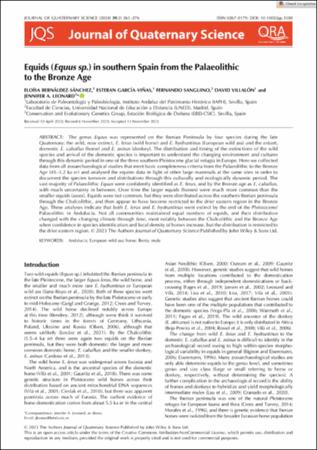
.jpg)
REPOSITORIO DE ACTIVOS DIGITALES
Depósito de documentos digitales reúne, difunde y preserva la documentación generada en los proyectos y actividades del Instituto Andaluz del Patrimonio Histórico.
https://hdl.handle.net/11532/381817
| Campo DC | Valor | Lengua/Idioma |
|---|---|---|
| dc.contributor.author | Bernáldez Sánchez, Eloísa | es_ES |
| dc.contributor.author | García-Viñas, Esteban | es_ES |
| dc.contributor.author | Sanguino, Fernando | es_ES |
| dc.contributor.author | Villalon-Torres, David | es_ES |
| dc.contributor.author | Leonard, Jennifer | es_ES |
| dc.contributor.editor | Costa, Cláudia | es_ES |
| dc.date.accessioned | 2025-06-11T12:53:39Z | - |
| dc.date.available | 2025-06-11T12:53:39Z | - |
| dc.date.issued | 2024 | - |
| dc.identifier.issn | 0267-8179 | es_ES |
| dc.identifier.uri | https://hdl.handle.net/11532/381817 | - |
| dc.description.abstract | The genus Equus was represented on the Iberian Peninsula by four species during the late Quaternary: the wild, now extinct, E. ferus (wild horse) and E. hydruntinus (European wild ass) and the extant, domestic E. caballus (horse) and E. asinus (donkey). The distribution and timing of the extinctions of the wild species and arrival of the domestic species is important to understand the changing environment and cultures through this dynamic period in one of the three southern Pleistocene glacial refugia in Europe. Here we collected data from all zooarchaeological studies that meet basic completeness criteria from the Palaeolithic to the Bronze Age (45–3.2 ka BP) and analysed the equine data in light of other large mammals at the same sites in order to document the species turnover and distributions through this culturally and ecologically dynamic period. The vast majority of Palaeolithic Equus were confidently identified as E. ferus, and by the Bronze age as E. caballus, with much uncertainty in between. Over time the larger equids (horses) were much more common than the smaller equids (asses). Equids were not common, but they were distributed across the southern Iberian peninsula through the Chalcolithic, and then appear to have become restricted to the drier eastern region in the Bronze Age. These analyses indicate that both E. ferus and E. hydruntinus went extinct by the end of the Pleistocene/ Palaeolithic in Andalucia. Not all communities maintained equal numbers of equids, and their distribution changed with the changing climate through time, most notably between the Chalcolithic and the Bronze Age when confidence in species identification and local density of horses increase, but the distribution is restricted to the drier eastern region. | es_ES |
| dc.format.medium | es_ES | |
| dc.language | Inglés | es_ES |
| dc.language.iso | spa | es_ES |
| dc.publisher | John Wiley & Sons | es_ES |
| dc.rights | info:eu-repo/semantics/restrictedAccess | es_ES |
| dc.rights.uri | http://creativecommons.org/licenses/by-nc-sa/3.0/deed.es | es_ES |
| dc.source | Journal of Quaternary Science, 2024, nº 39, pp. 261-276 | es_ES |
| dc.subject | Caballos | es_ES |
| dc.subject | Paleobiología | es_ES |
| dc.subject | Arqueozoología | es_ES |
| dc.title | Equids (Equus sp.) in southern Spain from the Palaeolithic to the Bronze Age | es_ES |
| dc.type | info:eu-repo/semantics/article | es_ES |
| iaph.disponibilidad.externo | Consulta, reproducción, uso público | es_ES |
| iaph.disponibilidad.interno | Consulta, reproducción, uso público | es_ES |
| dc.identifier.doi | 10.1002/jqs.3580 | es_ES |
| dc.rights.accessrights | info:eu-repo/semantics/restrictedAccess | es_ES |
| Aparece en las colecciones: | Artículos en publicaciones seriadas | |
| Fichero | Descripción | Tamaño | Formato | |
|---|---|---|---|---|
| equids_bernaldez_garcía_sanguino_JQS_.pdf Acceso Restringido | 3,44 MB | Adobe PDF |  Ver |
Los ítems de IAPH están protegidos por copyright, con todos los derechos reservados, a menos que se indique lo contrario.
Exportar registro
Ítems relacionados
Lupiáñez Corpas, Natividad; García-Viñas, Esteban; Villalón Torres, David; Comellas, Anna; Bernáldez Sánchez, Eloísa; Leonard, Jennifer A.
Bernáldez Sánchez, Eloísa; García-Viñas, Esteban; Sanguino-González, Fernando; Leonard, Jennifer A.
Bernáldez Sánchez, Eloísa; García-Viñas, Esteban; Gamero Esteban, Miguel; Ocaña García de Veas, Aurora; Leonard, Jennifer A.; Porta, Javier; Porta, Jose M.
Bernáldez Sánchez, Eloísa; García-Viñas, Esteban; Sánchez Donoso, Inés; Leonard, Jennifer A.
Bernáldez Sánchez, Eloísa; García-Viñas, Esteban; Sánchez Donoso, Inés; Leonard, Jennifer A.








